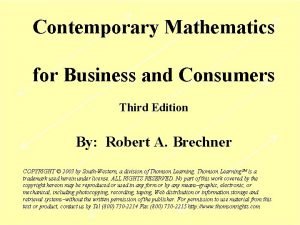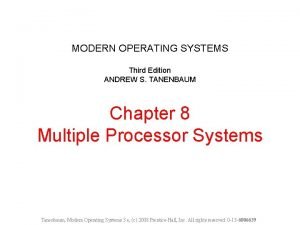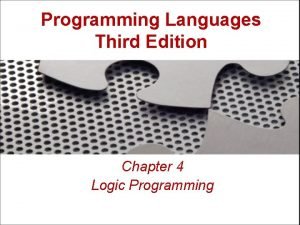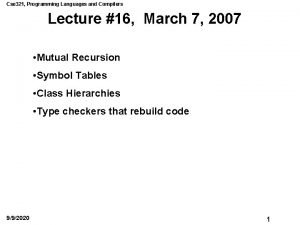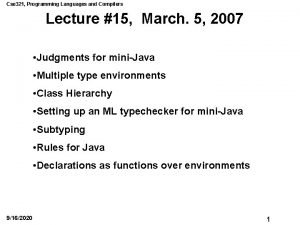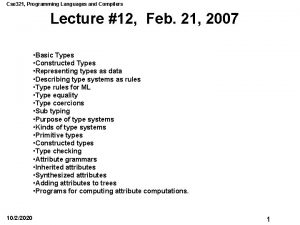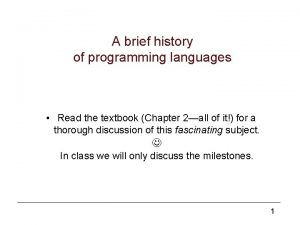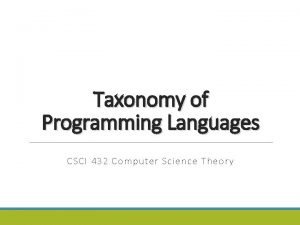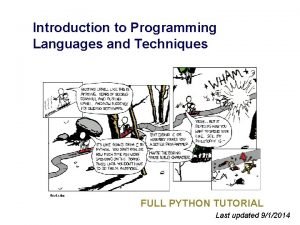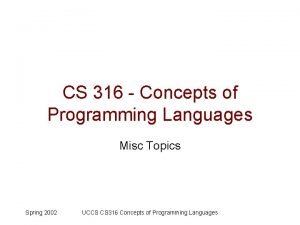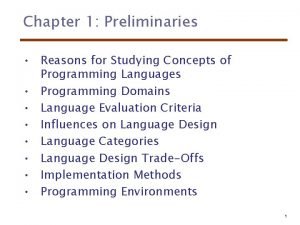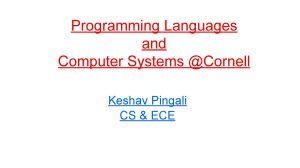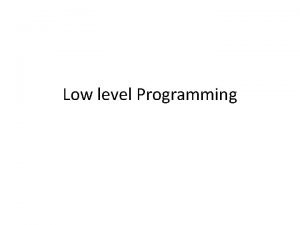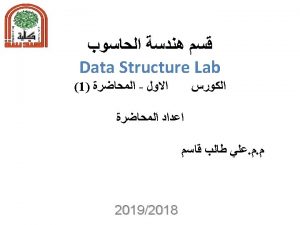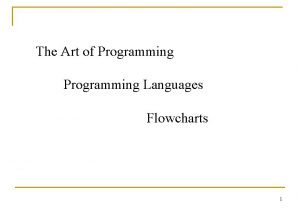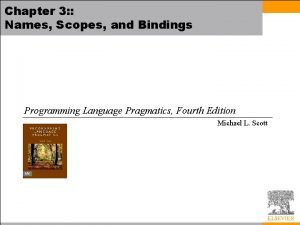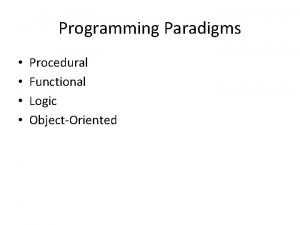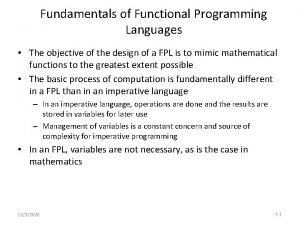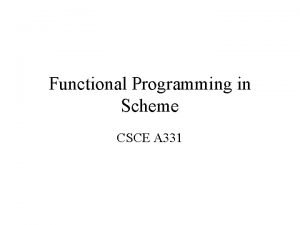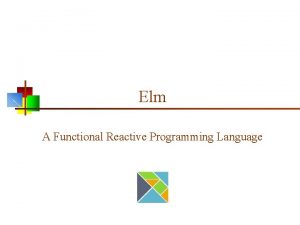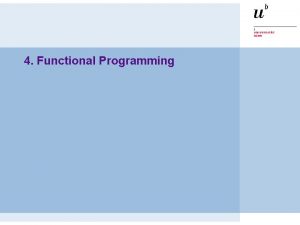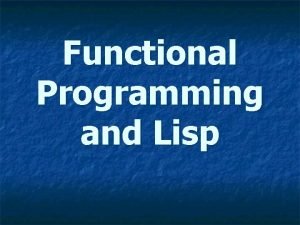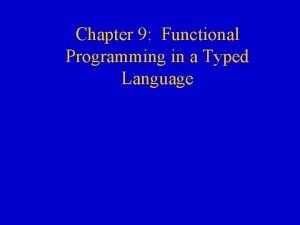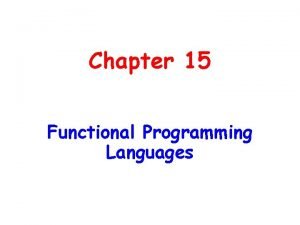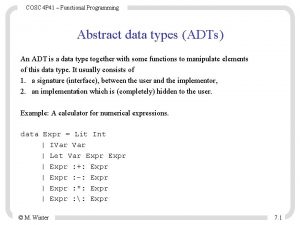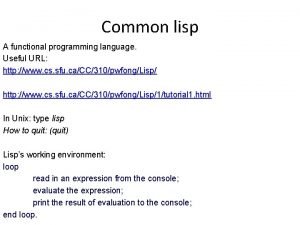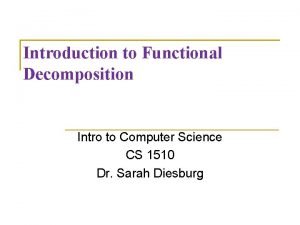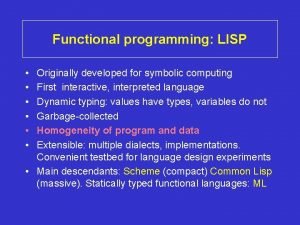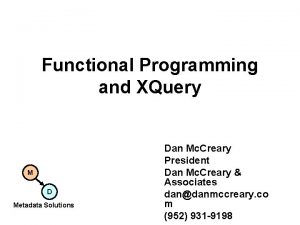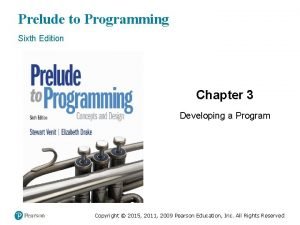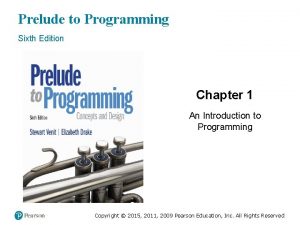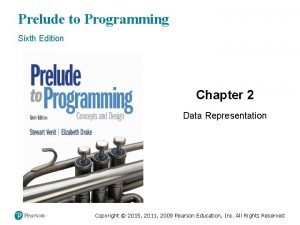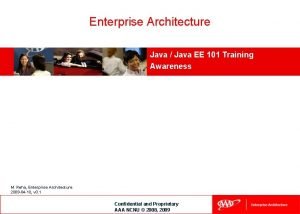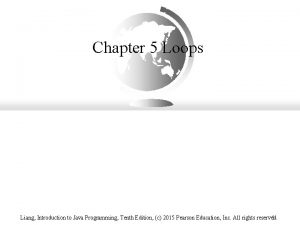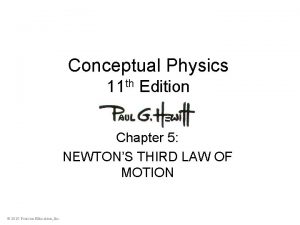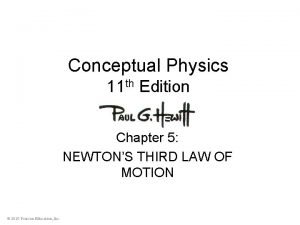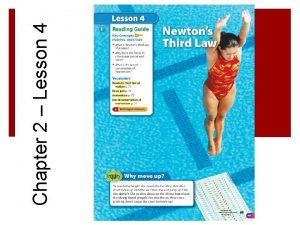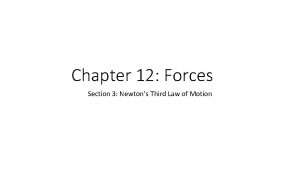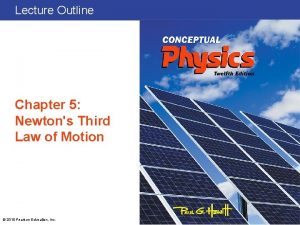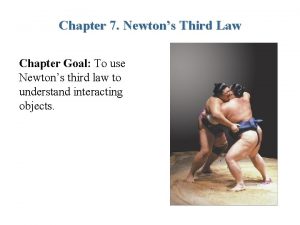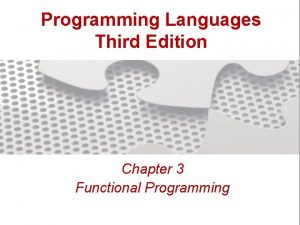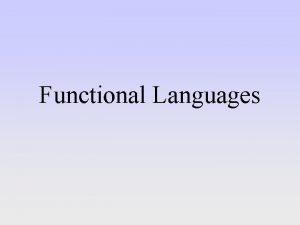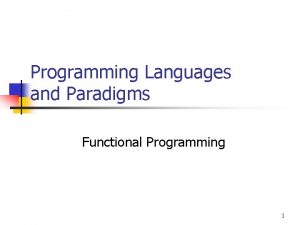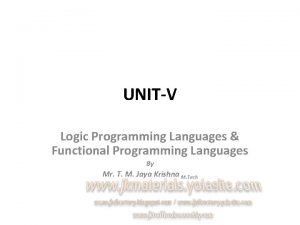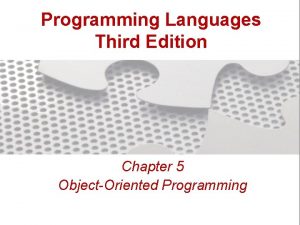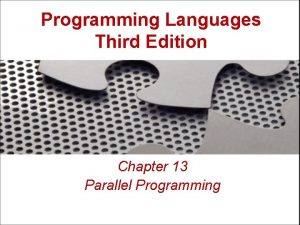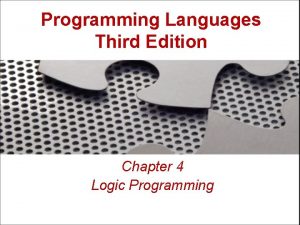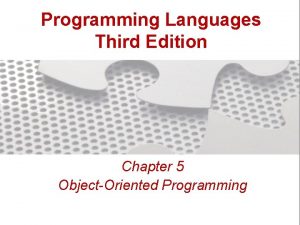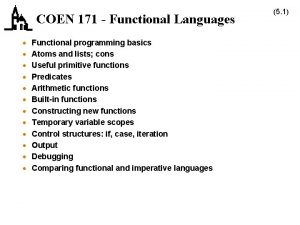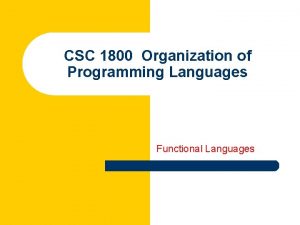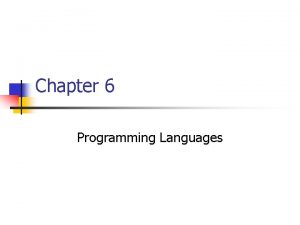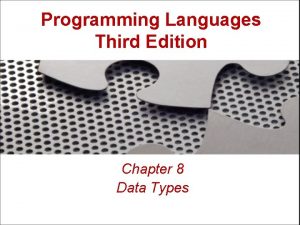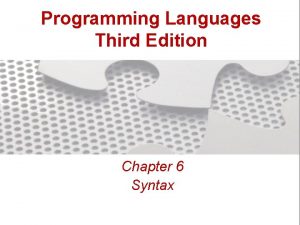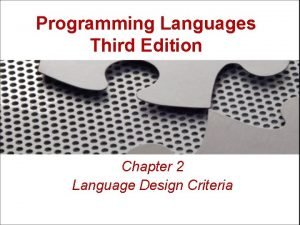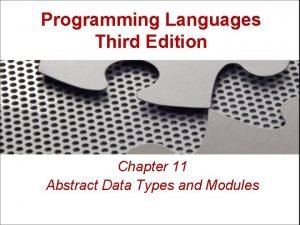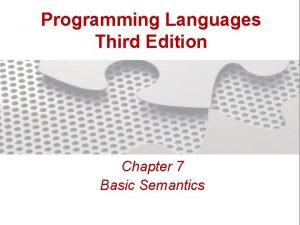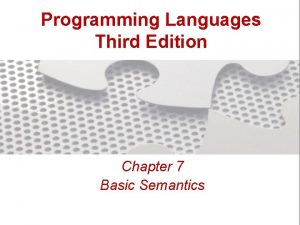Programming Languages Third Edition Chapter 3 Functional Programming




















































































- Slides: 84

Programming Languages Third Edition Chapter 3 Functional Programming

Objectives • • • Understand the concepts of functional programming Become familiar with Scheme Become familiar with ML Understand delayed evaluation Become familiar with Haskell Understand the mathematics of functional programming Programming Languages, Third Edition 2

Background • Several different styles of programming, including: – Functional programming – Logic programming – Object-oriented programming • Different languages have evolved to support each style of programming – Each type of language rests on a distinct model of computation, which is different from the von Neumann model Programming Languages, Third Edition 3

Background (cont’d. ) • Functional programming: – Provides a uniform view of programs as functions – Treats functions as data – Provides prevention of side effects • Functional programming languages generally have simpler semantics and a simpler model of computation – Useful for rapid prototyping, artificial intelligence, mathematical proof systems, and logic applications Programming Languages, Third Edition 4

Background (cont’d. ) • Until recently, most functional languages suffered from inefficient execution – Most were originally interpreted instead of compiled • Today, functional languages are very attractive for general programming – They lend themselves very well to parallel execution – May be more efficient than imperative languages on multicore hardware architectures – Have mature application libraries Programming Languages, Third Edition 5

Background (cont’d. ) • Despite these advantages, functional languages have not become mainstream languages for several reasons: – Programmers learn imperative or object-oriented languages first – OO languages provide a strong organizing principle for structuring code that mirrors the everyday experience of real objects • Functional methods such as recursion, functional abstraction, and higher-order functions have become part of many programming languages Programming Languages, Third Edition 6

Programs as Functions • A program is a description of specific computation • If we ignore the “how” and focus on the result, or the “what” of the computation, the program becomes a virtual black box that transforms input into output – A program is thus essentially equivalent to a mathematical function • Function: a rule that associates to each x from set of X of values a unique y from a set Y of values Programming Languages, Third Edition 7

Programs as Functions (cont’d. ) • In mathematical terminology, the function can be written as y=f(x) or f: X Y • Domain of f: the set X • Range of f: the set Y • Independent variable: the x in f(x), representing any value from the set X • Dependent variable: the y from the set Y, defined by y=f(x) • Partial function: occurs when f is not defined for all x in X Programming Languages, Third Edition 8

Programs as Functions (cont’d. ) • Total function: a function that is defined for all x in the set X • Programs, procedures, and functions can all be represented by the mathematical concept of a function – At the program level, x represents the input, and y represents the output – At the procedure or function level, x represents the parameters, and y represents the returned values Programming Languages, Third Edition 9

Programs as Functions (cont’d. ) • Functional definition: describes how a value is to be computed using formal parameters • Functional application: a call to a defined function using actual parameters, or the values that the formal parameters assume for a particular computation • In math, there is not always a clear distinction between a parameter and a variable – The term independent variable is often used for parameters Programming Languages, Third Edition 10

Programs as Functions (cont’d. ) • A major difference between imperative programming and functional programming is the concept of a variable – In math, variables always stand for actual values – In imperative programming languages, variables refer to memory locations that store values • Assignment statements allow memory locations to be reset with new values – In math, there are no concepts of memory location and assignment Programming Languages, Third Edition 11

Programs as Functions (cont’d. ) • Functional programming takes a mathematical approach to the concept of a variable – Variables are bound to values, not memory locations – A variable’s value cannot change, which eliminates assignment as an available operation • Most functional programming languages retain some notion of assignment – It is possible to create a pure functional program that takes a strictly mathematical approach to variables Programming Languages, Third Edition 12

Programs as Functions (cont’d. ) • Lack of assignment makes loops impossible – A loop requires a control variable whose value changes as the loop executes – Recursion is used instead of loops • There is no notion of the internal state of a function – Its value depends only on the values of its arguments (and possibly nonlocal variables) • A function’s value cannot depend on the order of evaluation of its arguments – An advantage for concurrent applications Programming Languages, Third Edition 13

Programs as Functions (cont’d. ) Programming Languages, Third Edition 14

Programs as Functions (cont’d. ) • Referential transparency: the property whereby a function’s value depends only on the values of its variables (and nonlocal variables) • Examples: – gcd function is referentially transparent – rand function is not because it depends on the state of the machine and previous calls to itself • A referentially transparent function with no parameters must always return the same value – Thus it is no different than a constant Programming Languages, Third Edition 15

Programs as Functions (cont’d. ) • Referential transparency and the lack of assignment make the semantics straightforward • Value semantics: semantics in which names are associated only to values, not memory locations • Lack of local state in functional programming makes it opposite of OO programming, wherein computation proceeds by changing the local state of objects • In functional programming, functions must be general language objects, viewed as values themselves Programming Languages, Third Edition 16

Programs as Functions (cont’d. ) • In functional programming, functions are first-class data values – Functions can be computed by other functions – Functions can be parameters to other functions • Composition: essential operation on functions – A function takes two functions as parameters and produces another function as its returned value • In math, the composition operator o is defined: If f: X Y and g: Y Z, then g o f: X Z is given by (g o f)(x) = g(f(x)) Programming Languages, Third Edition 17

Programs as Functions (cont’d. ) • Qualities of functional program languages and functional programs: – All procedures are functions that distinguish incoming values (parameters) from outgoing values (results) – In pure functional programming, there are no assignments – In pure functional programming, there are no loops – Value of a function depends only on its parameters, not on order of evaluation or execution path – Functions are first-class data values Programming Languages, Third Edition 18

Scheme: A Dialect of Lisp • Lisp (LISt Processing): first language that contained many of the features of modern functional languages – Based on the lambda calculus • Features included: – Uniform representation of programs and data using a single general structure: the list – Definition of the language using an interpreter written in the same language (metacircular interpreter) – Automatic memory management by the runtime system Programming Languages, Third Edition 19

Scheme: A Dialect of Lisp (cont’d. ) • No single standard evolved for Lisp, and there are many variations • Two dialects that use static scoping and a more uniform treatment of functions have become standard: – Common Lisp – Scheme Programming Languages, Third Edition 20

The Elements of Scheme • All programs and data in Scheme are considered expressions • Two types of expressions: – Atoms: like literal constants and identifiers of an imperative language – Parenthesized expression: a sequence of zero or more expressions separated by spaces and surrounded by parentheses • Syntax is expressed in extended Backus-Naur form notation Programming Languages, Third Edition 21

The Elements of Scheme (cont’d. ) Programming Languages, Third Edition 22

The Elements of Scheme (cont’d. ) • Syntax of Scheme: expression atom | ‘(‘ {expression} ’)’ atom number | string | symbol | character | boolean • When parenthesized expressions are viewed as data, they are called lists • Evaluation rule: the meaning of a Scheme expression • An environment in Scheme is a symbol table that associates identifiers with values Programming Languages, Third Edition 23

The Elements of Scheme (cont’d. ) • Standard evaluation rule for Scheme expressions: – Atomic literals evaluate to themselves – Symbols other than keywords are treated as identifiers or variables that are looked up in the current environment and replaced by values found there – A parenthesized expression or list is evaluated in one of two ways: • If the first item is a keyword, a special rule is applied to evaluate the rest of the expression • An expression starting with a keyword is called a special form Programming Languages, Third Edition 24

The Elements of Scheme (cont’d. ) • Otherwise, the parenthesized expression is a function application • Each expression within the parentheses is evaluated recursively • The first expression must evaluate to a function, which is then applied to remaining values (its arguments) • The Scheme evaluation rule implies that all expressions must be written in prefix form – Example: (+ 2 3) • + is a function, and it is applied to the values 2 and 3, to return the value 5 Programming Languages, Third Edition 25

The Elements of Scheme (cont’d. ) • Evaluation rule also implies that the value of a function (as an object) is clearly distinguished from a call to the function – Function is represented by the first expression in an application – Function call is surrounded by parentheses • Evaluation rule represents applicative order evaluation: – All subexpressions are evaluated first – A corresponding expression tree is evaluated from leaves to root Programming Languages, Third Edition 26

The Elements of Scheme (cont’d. ) Programming Languages, Third Edition 27

The Elements of Scheme (cont’d. ) • Example: (* (+ 2 3) (+ 4 5 )) – Two additions are evaluated first, then the multiplication Programming Languages, Third Edition 28

The Elements of Scheme (cont’d. ) • A problem arises when data are represented directly in a program, such as a list of numbers • Example: (2. 1 2. 2 3. 1) – Scheme will try to evaluate it as a function call – Must prevent this and consider it to be a list literal, using a special form with the keyword quote • Example: (quote (2. 1 2. 2 3. 1)) • Rule for evaluating a quote special form is to simply return the expression following quote without evaluating it Programming Languages, Third Edition 29

The Elements of Scheme (cont’d. ) • Loops are provided by recursive call • Selection is provided by special forms: – if form: like an if-else construct – cond form: like an if-elseif construct; cond stands for conditional expression Programming Languages, Third Edition 30

The Elements of Scheme (cont’d. ) • Neither the if nor the cond special form obey the standard evaluation rule – If they did, all arguments would be evaluated each time, rendering them useless as control mechanisms – Arguments to special forms are delayed until the appropriate moment • Scheme function applications use pass by value, while special forms in Scheme and Lisp use delayed evaluation Programming Languages, Third Edition 31

The Elements of Scheme (cont’d. ) • Special form let: binds a variable to a value within an expression – Example: (let ((a 2) (b 3)) (+ 1 b)) • First expression in a let is a binding list • let provides a local environment and scope for a set of variable names – Similar to temporary variable declarations in blockstructured languages – Values of the variables can be accessed only within the let form, not outside it Programming Languages, Third Edition 32

The Elements of Scheme (cont’d. ) • lambda special form: creates a function with the specified formal parameters and a body of code to be evaluated when the function is applied – Example: (lambda (radius) (* 3. 14 (* radius))) – Can apply the function to an argument by wrapping it and the argument in another set of parentheses: ((lambda (radius) (* 3. 14 (* radius))) 10) Programming Languages, Third Edition 33

The Elements of Scheme (cont’d. ) • Can bind a name to a lambda within a let: (let ((circlearea (lambda (radius) (* 3. 14 (* radius))))) (circlearea 10)) • let cannot be used to define recursive functions since let bindings cannot refer to themselves or each other • letrec special form: works like a let but allows arbitrary recursive references within the binding list (letrec ((factorial (lambda (n) (if (= n 0) 1 (* n (factorial (- n 1))))))) (factorial 10) Programming Languages, Third Edition 34

The Elements of Scheme (cont’d. ) • let and letrec forms create variables visible within the scope and lifetime of the let or letrec • define special form: creates a global binding of a variable visible in the top-level environment Programming Languages, Third Edition 35

Dynamic Type Checking • Scheme’s semantics include dynamic or latent type checking – Only values, not variables, have data types – Types of values are not checked until necessary at runtime • Automatic type checking happens right before a primitive function, such as + • Arguments to programmer-defined functions are not automatically checked • If wrong type, Scheme halts with an error message Programming Languages, Third Edition 36

Dynamic Type Checking (cont’d. ) • Can use built-in type recognition functions such as number? and procedure? to check a value’s type – This slows down programmer productivity and the code’s execution speed Programming Languages, Third Edition 37

Tail and Non-Tail Recursion • Because of runtime overhead for procedure calls, loops are always preferable to recursion in imperative languages • Tail recursive: when the recursive steps are the last steps in any function – Scheme compiler translates this to code that executes as a loop with no additional overhead for function calls other than the top-level call – Eliminates the performance hit of recursion Programming Languages, Third Edition 38

Tail and Non-Tail Recursion (cont’d. ) Programming Languages, Third Edition 39

Tail and Non-Tail Recursion (cont’d. ) • Non-tail recursive function example in Figure 3. 4: – After each recursive call, the value returned by the call must be multiplied by n (the argument to the previous call) – Requires a runtime stack to track the value of this argument for each call as the recursion unwinds – Entails a linear growth of memory and a substantial performance hit Programming Languages, Third Edition 40

Tail and Non-Tail Recursion (cont’d. ) • Tail recursive function example in Figure 3. 4: – All the work of computing values is done when the arguments are evaluated before each recursive call – Argument result is used to accumulate intermediate products on the way down through the recursive calls – No work remains to be done after each recursive call, so no runtime stack is necessary to remember arguments of previous calls Programming Languages, Third Edition 41

Data Structures in Scheme • Basic data structure in Scheme is the list – Can represent a sequence, a record, or any other structure • Scheme also supports structured types for vectors (one-dimensional arrays) and strings • List functions: – car: accesses the head of the list – cdr: returns the tail of the list (minus the head) – cons: adds a new head to an existing list Programming Languages, Third Edition 42

Data Structures in Scheme (cont’d. ) • Example: a list representation of a binary search tree ("horse" ("cow" () ("dog" () ())) ("zebra" ("yak" () () )) • A tree node is a list of three items (name left right) Programming Languages, Third Edition 43

Data Structures in Scheme (cont’d. ) • List can be visualized as a pair of values: the car and the cdr – List L is a pointer to a box of two pointers, one to its car and the other to its cdr Programming Languages, Third Edition 44

Data Structures in Scheme (cont’d. ) • Box and pointer notation for a simple list (1 2 3) – Black rectangle in the end box stands for the empty list ( ) Programming Languages, Third Edition 45

Data Structures in Scheme (cont’d. ) Programming Languages, Third Edition 46

Data Structures in Scheme (cont’d. ) • All the basic list manipulation operations can be written as functions using the primitives car, cdr, cons, and null? – null? returns true if the list is empty or false otherwise Programming Languages, Third Edition 47

Programming Techniques in Scheme • Scheme relies on recursion to perform loops and other repetitive operations – To apply repeated operations to a list, “cdr down and cons up”: apply the operation recursively to the tail of a list and then use the cons operator to construct a new list with the current result • Example: (define square-list (lambda (L) (if (null? L) '() (cons (* (car L)) (square-list (cdr L))))) Programming Languages, Third Edition 48

Higher-Order Functions • Higher-order functions: functions that take other functions as parameters and functions that return functions as values • Example: function with a function parameter that returns a function value (define make-double (lambda (f) (lambda (x) (f x x))) • Can now create functions using this: (define square (make-double *)) (define double (make-double +)) Programming Languages, Third Edition 49

Higher-Order Functions (cont’d. ) • Runtime environment of functional languages is more complicated than the stack-based environment of a standard block-structured imperative language • Garbage collection: automatic memory management technique to return memory used by functions Programming Languages, Third Edition 50

Static (Lexical) Scoping • Early dialects of Lisp were dynamically scoped • Modern dialects, including Scheme and Common Lisp, are statically scoped • Static scope (or lexical scope): the area of a program in which a variable declaration is visible – For static scoping, the meaning or value of a variable can be determined by reading the source code – For dynamic scoping, the meaning depends on the runtime context Programming Languages, Third Edition 51

Static (Lexical) Scoping (cont’d. ) • Declaration of variables can be nested in blockstructured languages • Scope of a variable extends to the end of the block in which it is declared, including any nested blocks (unless it is redeclared within a nesting block) Programming Languages, Third Edition 52

Static (Lexical) Scoping (cont’d. ) • Free variable: a variable referenced within a function that is not also a formal parameter to that function and is not bound within a nested function • Bound variable: a variable within a function that is also a formal parameter to that function • Lexical scoping fixes the meaning of free variables in one place in the code, making a program easier to read and verify than dynamic scoping Programming Languages, Third Edition 53

Symbolic Information Processing and Metalinguistic Power • Metalinguistic power: the capacity to build, manipulate, and transform lists of symbols that are then evaluated as programs • Example: let form is actually syntactic sugar for the application of a lambda form to its arguments Programming Languages, Third Edition 54

Delayed Evaluation • In a language with an applicative order evaluation rule, all parameters to user-defined functions are evaluated at the time of a call • Examples that do not use applicative order evaluation: – Boolean special forms and or – if special form • Short-circuit evaluation of Boolean expressions allows a result without evaluating the second parameter Programming Languages, Third Edition 55

Delayed Evaluation (cont’d. ) • Delayed evaluation is necessary for if special form • Example: (if a b c) – Evaluation of b and c must be delayed until the result of a is known; then either b or c is evaluated, but not both • Must distinguish between forms that use standard evaluation (function applications) and those that do not (special forms) • Using applicative order evaluation for functions makes semantics and implementation easier Programming Languages, Third Edition 56

Delayed Evaluation (cont’d. ) • Nonstrict: a property of a function in which delayed evaluation leads to a well-defined result, even though subexpressions or parameters may be undefined • Languages with the property that functions are strict are easier to implement, although nonstrictness can be a desirable property • Algol 60 included delayed execution in its pass by name parameter passing convention – A parameter is evaluated only when it is actually used in the code of a called procedure Programming Languages, Third Edition 57

Delayed Evaluation (cont’d. ) • Example: Algol 60 delayed execution • When called as p(true, 1 div 0), it returns 1 since y is never reached in the code of p – The undefined expression 1 div 0 is never computed Programming Languages, Third Edition 58

Delayed Evaluation (cont’d. ) • In a language with function values, it is possible to delay evaluation of a parameter by enclosing it in a function “shell” (a function with no parameters) • Example: C pass by name equivalent Programming Languages, Third Edition 59

Delayed Evaluation (cont’d. ) • Such “shell” procedures are sometimes referred to as pass by name thunks, or just thunks • In Scheme and ML, the lambda and fn function value constructors can be used to surround parameters with function shells • Example: which can be called as follows: Programming Languages, Third Edition 60

Delayed Evaluation (cont’d. ) • delay special form: delays evaluation of its arguments and returns an object like a lambda “shell” or promise to evaluate its arguments • force special form: causes its parameter, a delayed object, to be evaluated • Previous function can now be written as: and called as: Programming Languages, Third Edition 61

Delayed Evaluation (cont’d. ) • Delayed evaluation can introduce inefficiency when the same delayed expression is repeatedly evaluated • Scheme uses a memoization process to store the value of the delayed object the first time it is forced and then return this value for each subsequent call to force – This is sometimes referred to as pass by need Programming Languages, Third Edition 62

Delayed Evaluation (cont’d. ) • Lazy evaluation: only evaluate an expression once it is actually needed • This can be achieved in a functional language without explicit calls to delay and force • Required runtime rules for lazy evaluation: – All arguments to user-defined functions are delayed – All bindings of local names in let and letrec expressions are delayed – All arguments to constructor functions are delayed Programming Languages, Third Edition 63

Delayed Evaluation (cont’d. ) • Required runtime rules for lazy evaluation (cont’d. ): – All arguments to other predefined functions are forced – All function-valued arguments are forced – All conditions in selection forms are forced • Lists that obey lazy evaluation may be called streams • Primary example of a functional language with lazy evaluation is Haskell Programming Languages, Third Edition 64

Delayed Evaluation (cont’d. ) • Generator-filter programming: a style of functional programming in which computation is separated into procedures that generate streams and other procedures that take streams as arguments • Generators: procedures that generate streams • Filters: procedures that modify streams • Same-fringe problem for lists: two lists have the same fringe if they contain the same non-null atoms in the same order Programming Languages, Third Edition 65

Delayed Evaluation (cont’d. ) • Example: these lists have the same fringe: ((2 (3)) 4) and (2 (3 4 ())) • To determine if two lists have the same fringe, must flatten them to just lists of their atoms • flatten function: can be viewed as a filter; reduces a list to a list of its atoms • Lazy evaluation will compute only enough of the flattened lists as necessary before their elements disagree Programming Languages, Third Edition 66

Delayed Evaluation (cont’d. ) • Delayed evaluation complicates the semantics and increases complexity in the runtime environment – Delayed evaluation has been described as a form of parallelism, with delay as a form of process suspension and force as a kind of process continuation • Side effects, in particular assignment, do not mix well with lazy evaluation Programming Languages, Third Edition 67

The Mathematics of Functional Programming: Lambda Calculus • Lambda calculus: invented by Alonzo Church in the 1930 s – A mathematical formalism for expressing computation by functions – Can be used as a model for purely functional programming languages • Many functional languages, including Lisp, ML and Haskell, were based on lambda calculus Programming Languages, Third Edition 68

Lambda Calculus (cont’d. ) • Lambda abstraction: the essential construct of lambda calculus: • Can be interpreted exactly as this Scheme lambda expression: – An unnamed function of parameter x that adds 1 to x • Basic operation of lambda calculus is the application of expressions such as the lambda abstraction Programming Languages, Third Edition 69

Lambda Calculus (cont’d. ) • This expression: – Represents the application of the function that adds 1 to x to the constant 2 • A reduction rule permits 2 to be substituted for x in the lambda, yielding this: Programming Languages, Third Edition 70

Lambda Calculus (cont’d. ) • Syntax for lambda calculus: • Third rule represents function application • Fourth rule gives lambda abstractions • Lambda calculus as defined here is fully curried Programming Languages, Third Edition 71

Currying • Lambdas can only describe functions of a single variable – (λn. (λm. …)) – A wrong example: (λn m. if m = 0 then n else …)) • Currying: the process of splitting multiple parameters into single parameters to higher-order functions – The general principle fname : : (type 1, type 2) -> type 3 => fname : : type 1 -> type 2 -> type 3 – e. g. , (+ 2 3) => ((+ 2) 3) CS 4303 Hong 72 Lin

Lambda Calculus (cont’d. ) • Lambda calculus variables do not occupy memory • The set of constants and the set of variables are not specified by the grammar – It is more correct to speak of many lambda calculi • In the expression – x is bound by the lambda – The expression E is the scope of the binding – Free occurrence: any variable occurrence outside the scope – Bound occurrence: an occurrence that is not free Programming Languages, Third Edition 73

Lambda Calculus (cont’d. ) • Different occurrences of a variable can be bound by different lambdas • Some occurrences of a variable may be bound, while others are free • Can view lambda calculus as modeling functional programming: – A lambda abstraction as a function definition – Juxtaposition of two expressions as function application Programming Languages, Third Edition 74

Bound and free variables • (λx. E) – The scope of the binding of the lambda is expression E – All occurrences of x in E are bound – All occurrences of x outside E are not bound by this lambda • e. g. , in (λx. + y x) – x is bound, like a local variable – y is free, like a nonlocal reference in the function CS 4303 Hong 75 Lin

Lambda Calculus (cont’d. ) • Typed lambda calculus: more restrictive form that includes the notion of data type, thus reducing the set of expressions that are allowed • Precise rules must be given for transforming expressions • Substitution (or function application): called beta -reduction in lambda calculus • Beta-abstraction: reversing the process of substitution • Beta-conversion: either beta-reduction or betaabstraction Programming Languages, Third Edition 76

Lambda Calculus (cont’d. ) • Name capture problem: when doing betaconversion and replacing variables that occur in nested scopes, an incorrect reduction may occur – Must change the name of the variable in the inner lambda abstraction (alpha-conversion) • Eta-conversion: allows for the elimination of “redundant” lambda abstractions – Helpful in simplifying curried definitions in functional languages Programming Languages, Third Edition 77

Beta-abstraction and beta-reduction • beta-reduction ((λx. + x 1) 2) => (+ 2 1) • beta-abstraction (+ 2 1) => ((λx. + x 1) 2) • beta-conversion ( -conversion) - betaabstraction or beta reduction ((λx. E) F) <=> E[F/x] where E[F/x] is E with all free occurrences of x replaced by F CS 4303 Hong 78 Lin

Alpha-conversion ( -conversion) • The name capture problem: if you substitute an expression with free variables into a lambda, one or more of those free variables may conflict with names bound by lambdas (and be captured by them), giving incorrect results (since variable bound/free status should not change) ((λx. (λy. + x y)) y) => (λy. + y y) • alpha-conversion – General form: (λx. E) <=> (λy. E[y/x]) and y does not occur in E – ((λx. (λy. + x y)) y) => ((λx. (λz. + x z)) y) => (λz. + y z) CS 4303 Hong 79 Lin

Eta-conversion ( -conversion) • The process of eliminating redundant lambda abstractions (λx. (E x)) <=> E if E contains no free occurrences of x • e. g. , – (λx. (+ 1 x)) => (+ 1) – (λx. (λy. (+ x y))) => (λx. (+ x)) => + CS 4303 Hong 80 Lin

Lambda Calculus (cont’d. ) • Applicative order evaluation (pass by value) vs. normal order evaluation (pass by name) • Example: evaluate this expression: – Use applicative order; replacing (1 2 3) by its value and then applying beta-reduction gives: – Use normal order; applying beta-reduction first and then evaluating gives: • Normal order evaluation is a kind of delayed evaluation Programming Languages, Third Edition 81

Lambda Calculus (cont’d. ) • Different results can occur, such as when parameter evaluation gives an undefined result – Normal order will still compute the correct value – Applicative order will give an undefined result • Functions that can return a value even when parameters are undefined are said to be nonstrict • Functions that are undefined when parameters are undefined are said to be strict • Church-Rosser theorem: reduction sequences are essentially independent of the order in which they are performed Programming Languages, Third Edition 82

Semantics • An expression is a normal form if there are no -reductions that can be performed on it. • The semantics of an expression in lambda calculus is expressed by converting it to a normal form, if possible. Such a normal form, if it exists, is unique, by the famous Church. Rosser Theorem. • Not all reduction sequences lead to a normal form: ( y. 2) (( x. x x)) CS 4303 Hong 83 Lin

Lambda Calculus (cont’d. ) • Fixed point: a function that when passed to another function as an argument returns a function • To define a recursive function in lambda calculus, we need a function Y for constructing a fixed point of the lambda expression for the function – Y is called a fixed-point combinator • Because by its nature, Y will actually construct a solution that is in some sense the “smallest”; one can refer to the least-fixed-point semantics of recursive functions in lambda calculus Programming Languages, Third Edition 84
 Forward caries definition
Forward caries definition Senile caries
Senile caries Principles of economics third edition
Principles of economics third edition Carboxylic acid h3o+ reaction
Carboxylic acid h3o+ reaction Organic chemistry third edition david klein
Organic chemistry third edition david klein Business mathematics third edition
Business mathematics third edition Modern operating systems tanenbaum
Modern operating systems tanenbaum Fundamentals of corporate finance third canadian edition
Fundamentals of corporate finance third canadian edition Fundamentals of corporate finance 3rd canadian edition
Fundamentals of corporate finance 3rd canadian edition Lifespan development third edition
Lifespan development third edition Lifespan development third edition
Lifespan development third edition Essential cell biology third edition
Essential cell biology third edition Dr ruth yates
Dr ruth yates Real-time systems and programming languages
Real-time systems and programming languages Elsa gunter uiuc
Elsa gunter uiuc Multithreading program in java
Multithreading program in java Cxc it
Cxc it Introduction to programming languages
Introduction to programming languages Plc programming languages
Plc programming languages Procedural programming languages
Procedural programming languages Comparative programming languages
Comparative programming languages Alternative programming languages
Alternative programming languages Types of programming languages
Types of programming languages Transmission programming languages
Transmission programming languages Cse 340 principles of programming languages
Cse 340 principles of programming languages Types of programming languages
Types of programming languages Xenia programming languages
Xenia programming languages Advantages of application software
Advantages of application software Mainstream programming languages
Mainstream programming languages Cse 340 principles of programming languages
Cse 340 principles of programming languages Programing languages
Programing languages Programming languages
Programming languages Programming languages
Programming languages Programming languages
Programming languages Language
Language Brief history of programming languages
Brief history of programming languages Taxonomy of programming languages
Taxonomy of programming languages Real time programming language
Real time programming language Eniac
Eniac If programming languages were cars
If programming languages were cars Reasons for studying concepts of programming languages
Reasons for studying concepts of programming languages Cornell programming languages
Cornell programming languages Low level programming languages
Low level programming languages Middle level programming languages
Middle level programming languages The art of programming
The art of programming Cs 421 programming languages and compilers
Cs 421 programming languages and compilers Iat 265
Iat 265 Storage management in programming languages
Storage management in programming languages Space maintainers classification
Space maintainers classification Functional and non functional plasma enzymes
Functional and non functional plasma enzymes Enzymes of blood plasma
Enzymes of blood plasma Functional and non functional
Functional and non functional Mis chapter 6
Mis chapter 6 Report
Report Functional programming vs object oriented
Functional programming vs object oriented Fundamentals of functional programming
Fundamentals of functional programming Functional programming scheme
Functional programming scheme Elm programming language
Elm programming language Functional programming roadmap
Functional programming roadmap Lisp functional programming
Lisp functional programming Typed functional programming
Typed functional programming Fundamentals of functional programming language
Fundamentals of functional programming language Adt functional programming
Adt functional programming Is lisp a functional programming language
Is lisp a functional programming language Functional decomposition programming
Functional decomposition programming Lisp functional programming
Lisp functional programming Functional programming
Functional programming Prelude to programming 6th edition
Prelude to programming 6th edition Prelude to programming 6th edition
Prelude to programming 6th edition Prelude to programming 6th edition
Prelude to programming 6th edition Java ee 101
Java ee 101 Introduction to java programming 10th edition quizzes
Introduction to java programming 10th edition quizzes Expert systems: principles and programming, fourth edition
Expert systems: principles and programming, fourth edition Perbedaan linear programming dan integer programming
Perbedaan linear programming dan integer programming Greedy vs dynamic
Greedy vs dynamic What is system programming
What is system programming Integer programming vs linear programming
Integer programming vs linear programming Definisi integer
Definisi integer Chapter 7 newton's third law of motion
Chapter 7 newton's third law of motion Conceptual physics chapter 5 newton's third law of motion
Conceptual physics chapter 5 newton's third law of motion Slightly tilted wings of airplanes deflect
Slightly tilted wings of airplanes deflect Chapter 2 lesson 4 newton's third law answer key
Chapter 2 lesson 4 newton's third law answer key Chapter 12 section 3 newton's third law answer key
Chapter 12 section 3 newton's third law answer key Slightly tilted wings of airplanes deflect
Slightly tilted wings of airplanes deflect Chapter 7 newton's third law
Chapter 7 newton's third law





